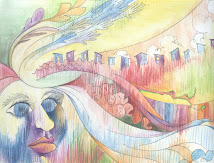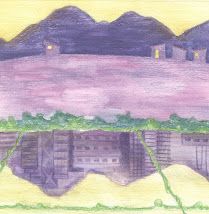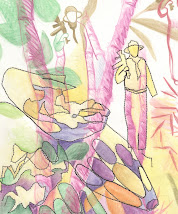Wednesday, October 15, 2008
context, context, context....
We are on our third location. We started in a church, in the central valley, filling a fellowship hall. Then we moved to Interplayce, “a dance studio”—for lack of a better description—in the heart of a city. A finally, on the walls of a seminary gallery, that used to be a library, sharing space with archeological artifacts from Jesus’ time (and earlier…). Some of the exhibition has not changed. The words of the poems are the same. Most of the panels are the same. The poster is the same. And much has changed. The work must change (we must change) with the context… whether it wants to or not. I should not have been as surprised as I felt when I discovered that despite my best efforts, I could not exactly duplicate the way the installation hung in its first location in the second location. It just would not work. So, we improvised, adapted and transformed.
And we do again. Our panels are attached to the walls of the Bade Museum at Pacific School of Religion, stretched and squished to fit. Yet, as awkward as that may feel, it also feels like coming home. The exhibition hangs across the quad from where we had out first meeting and started this journey almost exactly two years ago. The ground that birthed this movement within in us, made sacred by the transformation that happens here, is where we return. Though as holy as it was two years ago, it is not the same. It is a dynamic place. This will be as new, exciting and dynamic of an experience as that initial meeting—so full of dreams and possibility—was.
In the next two months, while unFound hangs in the hallowed halls of Holbrook, we will (re)discover, (un)find, and (trans)form along the way.
And we do again. Our panels are attached to the walls of the Bade Museum at Pacific School of Religion, stretched and squished to fit. Yet, as awkward as that may feel, it also feels like coming home. The exhibition hangs across the quad from where we had out first meeting and started this journey almost exactly two years ago. The ground that birthed this movement within in us, made sacred by the transformation that happens here, is where we return. Though as holy as it was two years ago, it is not the same. It is a dynamic place. This will be as new, exciting and dynamic of an experience as that initial meeting—so full of dreams and possibility—was.
In the next two months, while unFound hangs in the hallowed halls of Holbrook, we will (re)discover, (un)find, and (trans)form along the way.
Friday, October 3, 2008
watching us being watched
there is something fascinating about watching the way people approach your artwork. our the course of the development of this project, one of the priorities of this project was to ask people to approach the art work in an unfamiliar way, to make art that required people to engage more deeply than simply standing in front of a picture. we wanted our artwork to be a journey in and of itself. the result: an installation to invited engagement: touching to read all the poems, lighting incense, walking in bare feet, and maybe even pondering and praying. we wanted to pull more out of our audience.
so, on friday night, many people came to interplayce without knowing what to expect--both strangers, and people who knew the artists.
once the doors were open, there were four ways that strangers engaged (or didn't) our artwork.
1. poking head in the door and deciding it wasn't up his or her alley
2. coming a few feet in the door and reading the poster
3. coming ten feet in the door to read the booklet of poems and look at the installation from there
4. coming all the way into the room, walking around the installation, to read and engage all the work.
someone asked me if it bothered me that so many people peeked without coming in. i figured it was a natural result of this intention to encourage folks to engage in the artwork in a new way. not everyone will want to engage. that is that.
this was one of the interesting differences between displaying the installation in an art venue and in a church. at central united methodist, no one expected to engage art in their church, and with fewer expectations for what art should be, they were willing to engage. in an art venue, with a long list of expectations, that may have not been met, some people did not want to engage.
such is life. i hope we pushed the boundaries of art as much as we intended to.
so, on friday night, many people came to interplayce without knowing what to expect--both strangers, and people who knew the artists.
once the doors were open, there were four ways that strangers engaged (or didn't) our artwork.
1. poking head in the door and deciding it wasn't up his or her alley
2. coming a few feet in the door and reading the poster
3. coming ten feet in the door to read the booklet of poems and look at the installation from there
4. coming all the way into the room, walking around the installation, to read and engage all the work.
someone asked me if it bothered me that so many people peeked without coming in. i figured it was a natural result of this intention to encourage folks to engage in the artwork in a new way. not everyone will want to engage. that is that.
this was one of the interesting differences between displaying the installation in an art venue and in a church. at central united methodist, no one expected to engage art in their church, and with fewer expectations for what art should be, they were willing to engage. in an art venue, with a long list of expectations, that may have not been met, some people did not want to engage.
such is life. i hope we pushed the boundaries of art as much as we intended to.
Wednesday, October 1, 2008
unFound at Interplayce Oct. 3rd
Wednesday, September 17, 2008
How else do we recover and uncover our holy spaces...?
Since I started working on this project in 2007, I've been thinking about several different kinds of holy grounds that we traversed during our Jan. 2007 trip to S.E. Asia. And those spaces have triggered thoughts about other kinds of sacred space. Tonight, I want to highlight a few of the physical/geographical spaces that have haunted my memories for the past few months. (I think of this tonight b/c of a particular conversation that I carried with a few friends earlier this evening.)
(1) When we visited the Cu Chi Tunnels in Viet Nam, I marveled at the incredibly creative and dangerous tunnels and pathways that were carved into the ground. These tunnels were places that led to certain death for some soldiers. For other soldiers, these tunnels were sanctuaries, refuges, and security. For those of us who traveled through these tunnels in 2007, and for me especially, these tunnels were places filled with mystery and ambiguity. I scurried through them in fear (of the dark and other things) and in sadness, thinking of the tragic war that led to the building of these underground tunnels.
(2) The concrete ground of the dinosaur church in Stockton was a very different "holy ground". That was the space where we exhibited our memories for the first time -- memories and interpretations and reflections of the journeys that transformed our lives. In fact, we literally scattered some of the words of our memories onto the ground right in the middle of this space. We transformed it by bringing back the memories through our very presence.
(3) The 100+ steps of the temple in Malaysia which we visited. We walked up and down those steps, with me clinging to the side bars. I was deathly afraid of the height and feared I would fall every time I took a step up or down. That trail, that pathway took more of my energy and my time than anything. I thought about, worried over, feared, and admired those steps more than the huge golden statue of the god at the foot of the mountain (and standing guard at the top of the stairs). The people who went up and down those treacherous steps inspired more awe and respect and admiration from me b/c they went up and down those steps -- not because they bowed at the statue or because they lit some incense inside the cave temple. It was the act of traveling those stairs -- that treacherous ground -- that caught my attention.
(4) The sandy beach in Nha Trang was where we met our embodied "Jesus". As our group stood in barefeet in a circle, singing and breaking bread together, a homeless man entered our circle and talked with us and welcomed us and hugged us. We encountered a stranger who defied our stereotypes and who challenged our understandings of "sacred" and "community". The area where that encounter occurred was our sacred space -- a space where our mis/pre-conceptions were overturned, transformed, re-invented.
(1) When we visited the Cu Chi Tunnels in Viet Nam, I marveled at the incredibly creative and dangerous tunnels and pathways that were carved into the ground. These tunnels were places that led to certain death for some soldiers. For other soldiers, these tunnels were sanctuaries, refuges, and security. For those of us who traveled through these tunnels in 2007, and for me especially, these tunnels were places filled with mystery and ambiguity. I scurried through them in fear (of the dark and other things) and in sadness, thinking of the tragic war that led to the building of these underground tunnels.
(2) The concrete ground of the dinosaur church in Stockton was a very different "holy ground". That was the space where we exhibited our memories for the first time -- memories and interpretations and reflections of the journeys that transformed our lives. In fact, we literally scattered some of the words of our memories onto the ground right in the middle of this space. We transformed it by bringing back the memories through our very presence.
(3) The 100+ steps of the temple in Malaysia which we visited. We walked up and down those steps, with me clinging to the side bars. I was deathly afraid of the height and feared I would fall every time I took a step up or down. That trail, that pathway took more of my energy and my time than anything. I thought about, worried over, feared, and admired those steps more than the huge golden statue of the god at the foot of the mountain (and standing guard at the top of the stairs). The people who went up and down those treacherous steps inspired more awe and respect and admiration from me b/c they went up and down those steps -- not because they bowed at the statue or because they lit some incense inside the cave temple. It was the act of traveling those stairs -- that treacherous ground -- that caught my attention.
(4) The sandy beach in Nha Trang was where we met our embodied "Jesus". As our group stood in barefeet in a circle, singing and breaking bread together, a homeless man entered our circle and talked with us and welcomed us and hugged us. We encountered a stranger who defied our stereotypes and who challenged our understandings of "sacred" and "community". The area where that encounter occurred was our sacred space -- a space where our mis/pre-conceptions were overturned, transformed, re-invented.
Sunday, September 7, 2008
Drawing our selves in image and word
 Today, Abby and I went back to Central UMC in Stockton to lead workshops on art and poetry writing. After attending the 11:00 a.m. service with the congregation, we had a quick lunch prepared by one of the church ladies and then started talking about art and poetry.
Today, Abby and I went back to Central UMC in Stockton to lead workshops on art and poetry writing. After attending the 11:00 a.m. service with the congregation, we had a quick lunch prepared by one of the church ladies and then started talking about art and poetry. Abby started us off by asking us to describe our holy spaces. We then used various color tools to draw, sketch, etch, and basically color-convey our responses to her reading of the Matthew 16 passage about taking up our cross and following Jesus. For the first reading, we were asked to first use only colors (no shapes) as an expression of our response. Then, after the 2nd reading, we were asked to use lines and shapes to respond. After the third reading, we were to respond with specific images. After each section, we shared with one another what we had created, paying attention to acknowledging the beauty and meaning behind each of our creations.
In the poetry writing portion, we listened to the images in several poems and used our five senses to visualize our sacred spaces. We then used words we had written down to craft haiku. Without a lot of time remaining, we shared our haiku and thought about how effectively we used words -- language -- to express what we feel/sense/know/think about our holy spaces (which we talked about at the beginning of the art portion). I was amazed at the variety of haiku that we wrote, each with its own uniqueness.
Even though we had a few changes to our original plans, the overall experience was moving, transformative, and creative. I learned a great deal from these individuals about their lives, their passions, and their faiths. I hope they were able to bring away at least something meaningful from this experience.
Missed the opening? See the pictures!
unFound Opening: Reception & Reading
Central UMC, Stockton, CA
Friday, Sept. 5, 2008
Central UMC, Stockton, CA
Friday, Sept. 5, 2008
Saturday, September 6, 2008
It's official!
 Congratulations to unFound on officially opening in Stockton at Central UMC on Friday, 9/5!!
Congratulations to unFound on officially opening in Stockton at Central UMC on Friday, 9/5!!Abby and I arrived in CUMC at about 11:30 a.m. and we worked for hours setting up the space. One of the most amazing and challenging portions of the set-up was when I worked with the poem The Undoing. Abby had the brilliant idea of writing the text of the poem on the floor of the exhibit space, but b/c we couldn't actually write on the concrete, the text was written on contact paper, and Abby had to very tediously cut out portions of the poem. Putting the poem back together took forever -- complicated by the fact that I do not memorize (gasp!) my poems.
It was easy to identify the stanzas and to string together the primary words in each line, but w tripped me up were the articles, conjunctions, punctuations. It also took quite a long time to remove the contact paper backing and apply the words to the ground.
This particular step was helpful for me. It was literally a cut-and-paste revision. In my head, I was able to identify the unnecessary filler words that could be cut to pare the poem down to its essence. Something about the fiscality of cutting and pasting words on the ground really helped. It was amazing to see the poem cut apart into jumbled puzzle-pieces, then pieced together into meaningful lines that spiraled on the ground. We really immersed ourselves in "the undoing" of the poem!
Even though the Stockton heat was unbearable -- even with four fans blowing full blast in the hall -- we still had a great turn out. People walked in and out of the installation, looking carefully and looking hard for the tiny details found in the embroidered poems, in the hand-drawn outlines, and the ironed pages of books.
During the reading and presentation, I was amazed to see their open, attentive faces nodding in response to poems that were being read out loud. It was worth it just to see their reaction. And, I hope, their understanding of the poems will deepen their understanding and appreciation of the installation.
I can't possibly end this post without mentioning our host for the evening. The entire event at CUMC would not have happened without Alan's organization, management, hosting, and inspiration. We had great set-up and great food. The details were perfect, right down to the beautifully arrayed napkins and batik table centerpieces. We owe it all to Principal Alan Cook extraordinaire.
unFound: a poetry and visual art exhibition
Artwork designed by Abby King Kaiser
Poetry written by Hoang-Anh Tran
Hosted by Alan Cook!
Subscribe to:
Comments (Atom)





